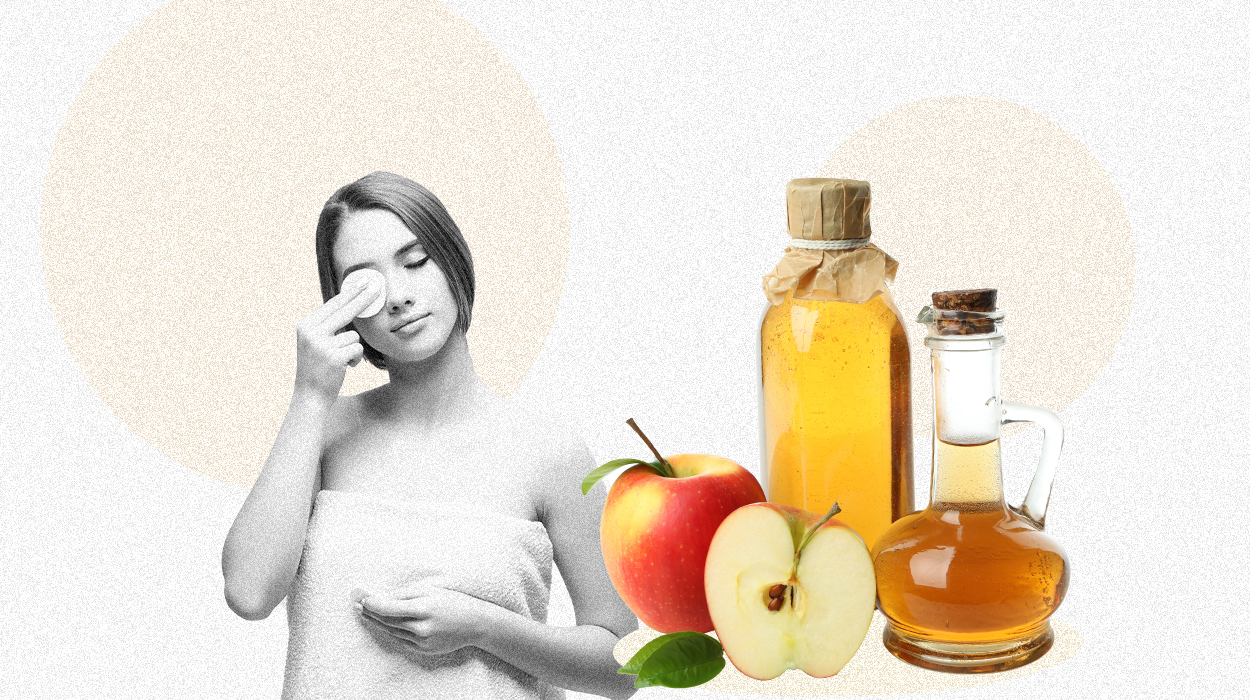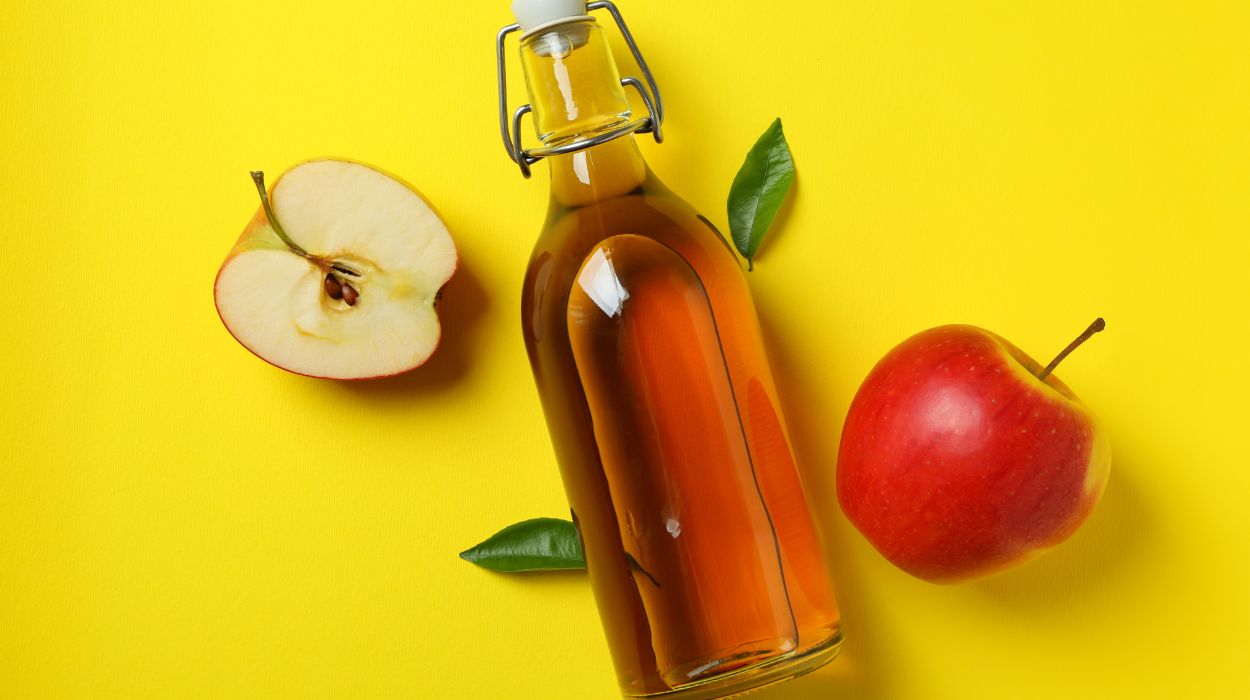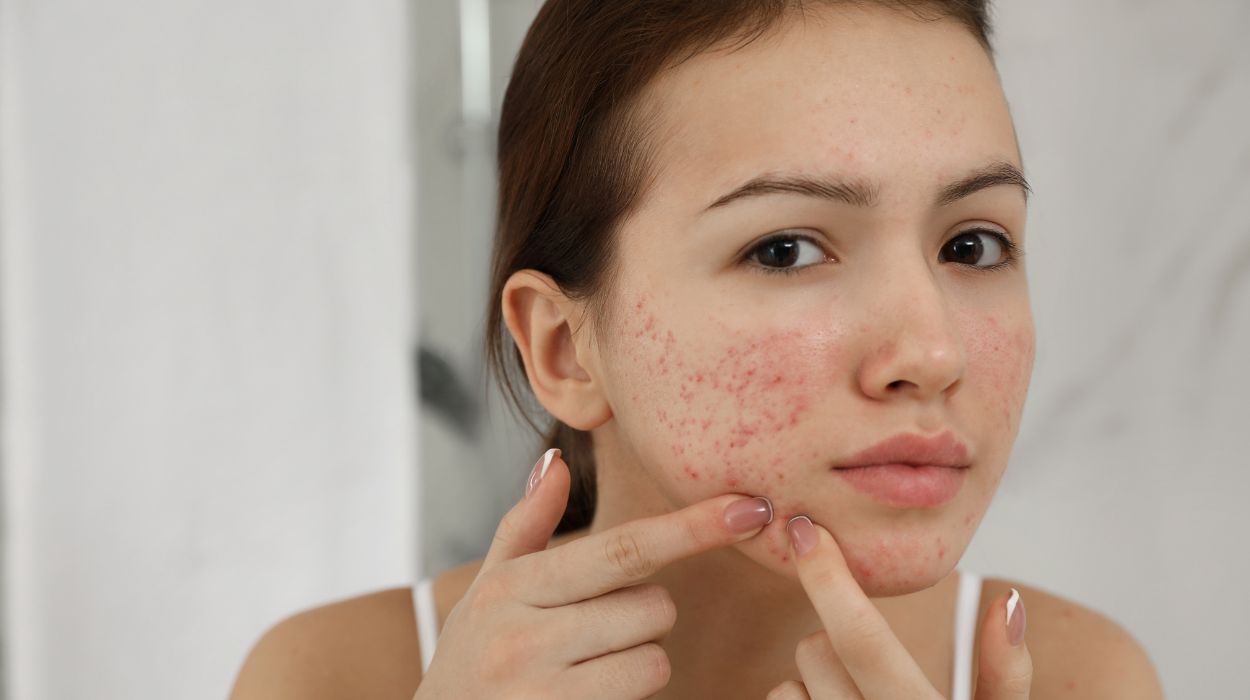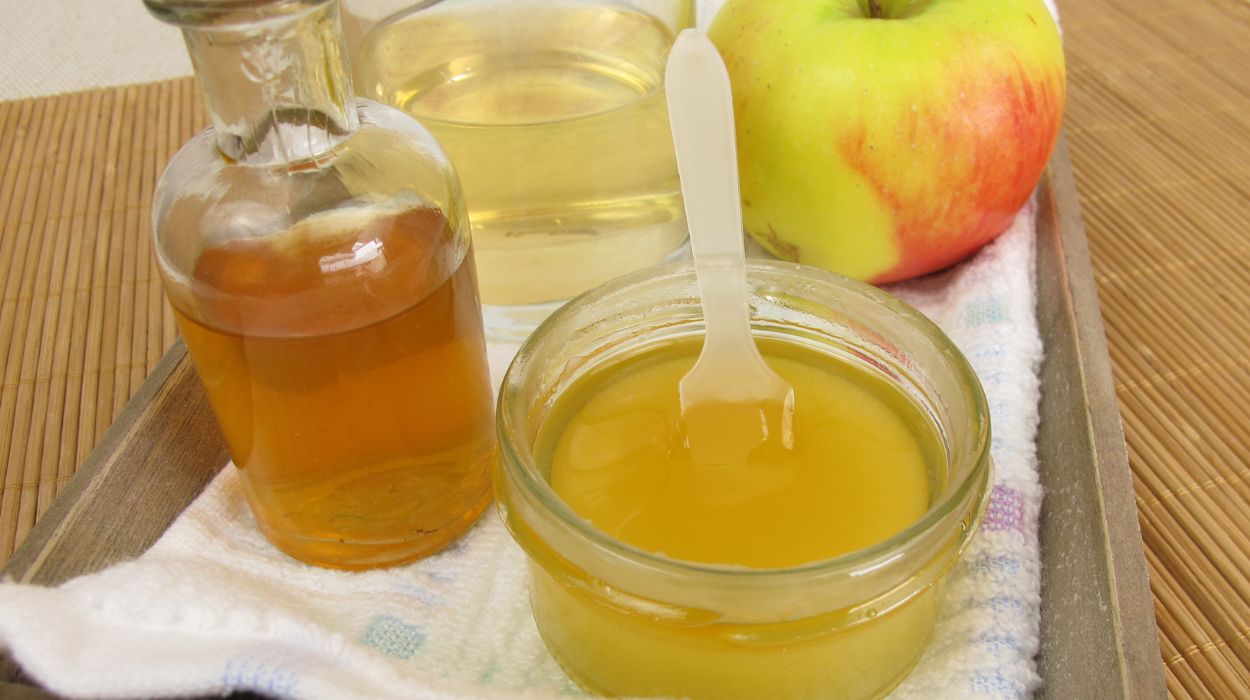 Expert's opinion
Expert's opinion
Expert's opinion
The article is a subjective view on this topic written by writers specializing in medical writing.
It may reflect on a personal journey surrounding struggles with an illness or medical condition, involve product comparisons, diet considerations, or other health-related opinions.
Although the view is entirely that of the writer, it is based on academic experiences and scientific research they have conducted; it is fact-checked by a team of degreed medical experts, and validated by sources attached to the article.
The numbers in parenthesis (1,2,3) will take you to clickable links to related scientific papers.
Apple Cider Vinegar Facial Toner: Benefits, Recipe & How To Use It In 2024

Apple cider vinegar has many uses and is among the best do-it-yourself (DIY) beauty products you can have at home. It’s always important to take good care of your skin, and a facial toner is part of the self-care package. Varying skin types require a skincare routine consisting of cleansing and toning daily to remove dead skin cells.
The good news is you can make facial toners at home using raw apple cider vinegar. All you need is apple cider vinegar, water, and additional ingredients like essential oils. The mixture is easy to use to improve your skin tone and ease the symptoms of acne.
In this article, you can learn how to use apple cider vinegar as a toner on your skin. The DIY toner is great, but you should also use it with caution. The best way to use apple cider vinegar (ACV) toner is by diluting it with water.
ACV Toner Benefits
The toner can offer various benefits to your skin:
- Anti-bacterial, anti-viral, and anti-fungal properties
- Restore skin pH
- May help tone oily skin
- Reduce the appearance of acne scars
- May treat hyperpigmentation
- Relieve sunburns
Apple Cider Vinegar Toner: Benefits

The toner may benefit your skin in many ways. It’s the first choice for many people with acne-prone skin types.
You can get many benefits when using raw apple cider vinegar on different skin types. It suits oily skin, natural skin, dry skin, sensitive skin, and normal skin.
Anti-bacterial, Anti-viral, And Anti-fungal Properties
Acne-prone skin types always have to find solutions for bacterial and fungal infections. Bacteria on the skin are among the leading causes of breakouts.[1]
However, when you use ACV toner, you create an environment on your skin that’s not conducive to microbial growth. The toner works as an anti-bacterial, anti-fungal, and anti-viral because of citric, lactic, malic, and acetic acids.
Raw apple cider vinegar has an acidic nature that’s excellent as a skin toner. It creates an environment on your skin where none of these microbes can flourish and cause cystic acne breakouts. This becomes an acidic environment that also helps lessen inflammation on your skin.
Restore Skin pH
Apple cider vinegar toners are good for you with a reactive skin type. Reactions happen when there’s an imbalance in the skin’s pH levels. Using an ACV toner is among the best ways to restore balance in the skin’s natural pH.
Usually, the skin has an acid mantle layer that acts as a protective layer. The layer has a pH of 4 to 6[2] and is quite delicate. While the skin’s normal pH is crucial, it’s easy to cause an imbalance when using certain soaps and shampoos.
Even water with a pH of 7 can affect the skin’s protective layer. As a result, microbes like bacteria gain access and wreak havoc. You suffer from free radicals and moisture loss[3] when the skin’s pH fluctuates.
The longer this happens, the more the effects such as inflammation and redness on the skin. However, when you use organic apple cider vinegar as a toner, you can restore the skin’s natural pH. This is crucial, especially if you have sensitive skin prone to cystic acne breakouts.
May Help Tone Oily Skin
Having an oily skin type means you have an excess production of sebum. Having excess oil on your skin can cause breakouts and acne flare-ups. This happens when the excess oil clogs your pores,[4] leading to inflammation and acne.
It’s common for people with oily skin to have enlarged pores. Apple cider vinegar has astringent properties, which prove quite beneficial to these skin pores. It gets rid of the excess oil on the skin and tightens the pores.
A toner is generally made by adding one part ACV to two parts of filtered water to dilute the acidity.
Reduce The Appearance Of Acne Scars

The facial toner that you get when using organic apple cider vinegar can help reduce the appearance of acne scars. While apple cider vinegar may not treat acne vulgaris, it may help with acne scars by lightening your skin.
While more research is needed, there’s evidence that ACV facial toner can work on minor acne scars. The natural toner has a chemical peel effect[5] on the skin through the action of acetic acid.[6]
Remember, the facial toner uses fermented apple cider vinegar that can kill bacteria. Other benefits include reducing inflammation and reducing the appearance of acne scars. Inflammation resulting from acne leads to lesions that remain as scars when the flareup ends
May Treat Hyperpigmentation
Hyperpigmentation or dark spots cause the skin to become dull and have patches. To get the best remedy, people use ACV toners to try and lighten these parts. Apple cider vinegar lightens the skin through the action of acetic acid’s chemical peel effect.
While it’s safe to use apple cider vinegar toner on different skin types, it’s better to do so with caution. Some people can experience skin lightening using ACV, while others experience a worsening of the dark spots. The burning effect of ACV requires testing the facial toner before using it on your entire face.
Relieve Sunburns
Prolonged exposure to the sun leads to sunburns due to damage to the skin. Using ACV toner can help reverse the effect thanks to its ability to restore the skin’s pH levels. You need to dilute apple cider vinegar and apply the mixture to sunburns for a soothing effect. Add a cup of ACV to a lukewarm bath and soak in it to ease sunburn stings. Or, mix equal parts of ACV with water, put in a spritz bottle, and spray on the skin.
How To Make ACV Toner

You need a few ingredients when you want to make ACV toner at home. Using apple cider vinegar DIY as a toner has numerous benefits to your skin, as listed above. Get a raw apple cider vinegar recipe to create this special liquid.
A simple ACV toner for acne consists of only two ingredients. You need:
- Organic apple cider vinegar
- Water
Use the two ingredients to dilute apple cider vinegar by mixing two tablespoons of ACV in 150 ml of water.
However, there is another apple cider vinegar toner recipe that you can prepare at home using natural ingredients.
For this apple cider vinegar DIY toner, you need:
- 2 tablespoons. ACV
- 8 ounces. Water
- 1 tablespoon Rosewater
- 1 tablespoon. Witch hazel if you have oily skin, not for sensitive or dry
- 3 drops of Essential oil (i.e. lavender, tea tree, lemongrass, or rosemary)
- 2 drops of Vitamin E oil
Fetch a glass container and add all the natural ingredients to make this DIY toner for your skincare routine. Before you use it all over your face, you can test the DIY toner on one spot to see how the skin responds.
The apple cider vinegar DIY toner is ready to use once you combine the ingredients. Use a small cotton ball and dip it into the ACV toner mixture. Apply natural toner on your face, targeting areas with acne vulgaris or dark spots. Use it to cleanse your face from bacteria and debris regularly.
After using it as a facial cleanser, you can use the toner mixture as part of your regular skincare regimen. Store any excess at room temperature after using the apple cider vinegar facial toner. Adding essential oils to the natural toners helps it have a better scent.
How To Use Apple Cider Vinegar As A Toner
Apple cider vinegar is ideal for all skin types as a facial toner. To remove dead skin cells, you can use the facial toner on dry skin, sensitive skin, or normal skin. Use a good skincare routine that starts with a facial cleanser before using your DIY toner.
However, as beneficial as this skin toner is, it’s best to use it with caution. For example, adding essential oils to ACV toner is good, but not for all skin types. It’s best to avoid essential oils like witch hazel when making a facial toner for sensitive skin or dry skin.
In addition, apple cider vinegar toners tend to dry your skin even more. So, if you have dry skin, it’s best to reduce the amount of ACV you add to the facial toner. Reducing the ACV in the mix helps prevent your skin from getting extra dry after using the apple cider vinegar facial toner.
Also, consider the type of water you use to dilute the apple cider vinegar when making the facial toner. If you use tap water, opt for soft water with fewer minerals. It won’t dry your skin like regular tap water. The best option is distilled water, which works best when making a skin toner.
Remember to always dilute your apple cider vinegar before using it on your skin. If you don’t, you might end up with skin burns. For example, a 14-year-old girl developed skin burns[7] after using undiluted ACV to remove moles. The chemical burn left her with scars.
The Bottom Line
Millions of people worldwide use apple cider vinegar in numerous ways. Among the best uses is as a facial toner. ACV toner suits all skin types but requires caution when using them. The facial toner has proven effective, especially on acne-prone skin.
Many of apple cider vinegar’s benefits encourage you to use it in your skincare routine. It’s ideal for balancing the skin’s pH levels when mixing with other ingredients like essential oils and vitamin E oil.
All you need is one of the simple DIY recipes, and you can make apple cider vinegar toner for acne scars. Consult a dermatologist if you have doubts about using ACV toner.
+ 17 sources
Health Canal avoids using tertiary references. We have strict sourcing guidelines and rely on peer-reviewed studies, academic researches from medical associations and institutions. To ensure the accuracy of articles in Health Canal, you can read more about the editorial process here
- McLaughlin, J., Watterson, S., Layton, A., Bjourson, A.J., Barnard, E. and McDowell, A. (2019). Propionibacterium acnes and Acne Vulgaris: New Insights from the Integration of Population Genetic, Multi-Omic, Biochemical and Host-Microbe Studies. Microorganisms, [online] 7(5), pp.128–128. doi:https://doi.org/10.3390/microorganisms7050128.
- Shu Hua Kuo, Ching Ju Shen, Ching Fen Shen and Cheng, C. (2020). Role of pH Value in Clinically Relevant Diagnosis. Diagnostics, [online] 10(2), pp.107–107. doi:https://doi.org/10.3390/diagnostics10020107.
- Jürgen Blaak and Staib, P. (2018). The Relation of pH and Skin Cleansing. Current problems in dermatology, [online] pp.132–142. doi:https://doi.org/10.1159/000489527.
- Endly, D.C. and Miller, R.A. (2017). Oily Skin: A review of Treatment Options. The Journal of clinical and aesthetic dermatology, [online] 10(8), pp.49–55. Available at: https://www.ncbi.nlm.nih.gov/pmc/articles/PMC5605215/
- A Kapuścińska and Nowak, I. (2015). Use of organic acids in acne and skin discolorations therapy. Postȩpy higieny i medycyny doświadczalnej, [online] 69, pp.374–383. doi:https://doi.org/10.5604/17322693.1145825.
- Elhage, K.G., Kayla St Claire and Daveluy, S. (2021). Acetic acid and the skin: a review of vinegar in dermatology. International Journal of Dermatology, [online] 61(7), pp.804–811. doi:https://doi.org/10.1111/ijd.15804.
- Feldstein (2015). Chemical Burn from Vinegar Following an Internet-based Protocol for Self-removal of Nevi. The Journal of clinical and aesthetic dermatology, [online] 8(6). Available at: https://pubmed.ncbi.nlm.nih.gov/26155328/



